Revision Notes for CBSE Class 10 Science Chapter 7: Check CBSE Class 10 Science Revision Notes for Chapter 7 - How Do Organisms Reproduce. These notes are best for quick revision and preparing effectively for the upcoming CBSE Class 10 Science Board Exam 2023-24. These quick revision notes are entirely based on the revised CBSE syllabus of Class 10 Science and the latest NCERT Science Book. Students will be able to revise the whole chapter within a few minutes with the help of these Science notes provided by Jagran Josh.
Also Read|
CBSE Class 10 Science Deleted Syllabus 2023-24
CBSE Class 10 Science Sample Paper 2023-24
Revision Notes for CBSE Class 10 Science Notes for Chapter 7 How Do Organisms Reproduce:
Reproduction: Reproduction is the process by which all living organisms produce new individuals of their own kind. Reproduction is essential for the survival of species on this earth.
DNA Copying in Reproduction
→ The basic event in reproduction is the creation of a DNA copy. Cells use chemical reactions to build copies of their DNA.
→ The process of copying the DNA may have some variations each time. As a result, the DNA copies generated will be similar, but may not be identical to the original.
Importance of copying of DNA during reproduction
The copying of DNA during reproduction is important because:
(i) It's helps in transferring of characters from parents to offspring
(ii) It maintains the characteristics in different generations of the species.
(iii) It also produces variations which are useful for the survival of species for long time..
What is the importance of variation?
(i) Variation helps organisms to adapt to the changes in environment.
(ii) It contributes to evolution
(iii) It is the basis of heredity.
(iv) It helps species to be resistant to diseases.
Types of Reproduction
It is mainly of two types:
1.Asexual reproduction: The production of new organism from a single parent without the involvement of sex cells (or gametes) is called asexual reproduction.
2.Sexual reproduction: The process of production of new organism from two parents by using sex cells (called gametes) is called sexual reproduction.
Modes of Asexual Reproduction
(i) Fission: In this the parent cell divides into daughter cells.
→ Binary fission: When the fission results in two daughter cells, it is binary fission. For example - Amoeba and Paramecium.
Reproduction in amoeba: When the amoeba cell reaches its maximum size, then first the nucleus of amoeba lengthen and divide into two parts following the division of cytoplasm of parent to form two smaller daughter cells .
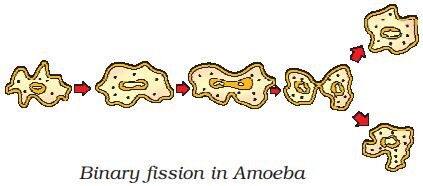
→ Multiple fission: When fission results in many daughter cells, it is called multiple. For example - Plasmodium.
Reproduction in plasmodium: During unfavourable condition a cyst or protective wall is formed around the cell of plasmodium. Inside the cyst, the nucleus of cell splits several times to form many daughter nuclei. Each daughter nuclei is surrounded by the cytoplasm collected inside a thin membrane. Thus, a number of new daughter cells are formed within the cyst. When the favourable conditions arrive the cyst breaks open and daughter cells are released each forming a new organism.
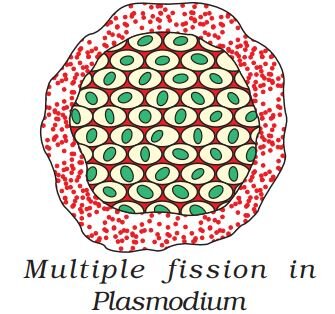
(ii) Fragmentation: In multi-cellular organisms, the organism breaks-up into smaller pieces upon maturation, each piece develops into new individual. For example - Spirogyra.
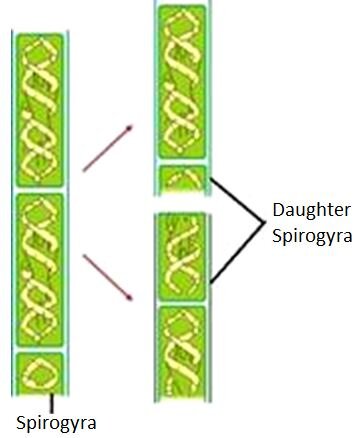
(iii) Regeneration: In this, a few organisms may give rise to new individual organisms from their body parts. For example - Hydra and Planaria.
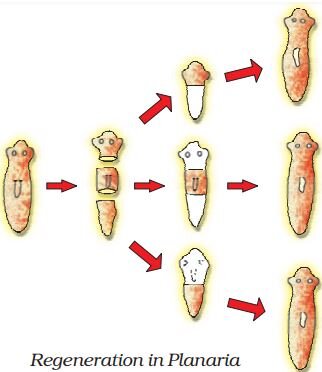
(iv) Budding: In some organisms, a bud is formed which develops into tiny individual. It detaches from parent body upon maturation and develops into a new individual. For example: Hydra
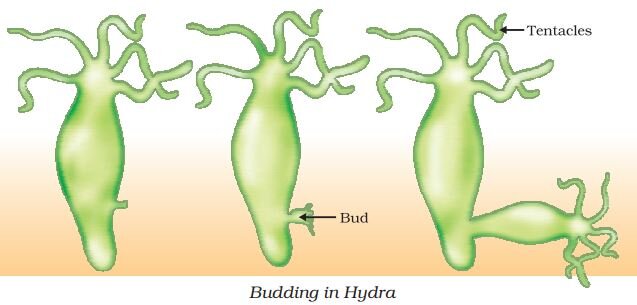
(v) Vegetative Propagation: It is the method of reproduction in which plants reproduce by their vegetative parts such as roots, stems and leaves.
It is of two types:
(a) Natural vegetative propagation: It can be done by the following methods
Cutting: A small vegetative part of the plant removed by cutting with sharp knife is called cutting. It is then planted in the soil to grow a new similar plant. For example - rose and sugarcane are grown by cutting.
Layering: In this method, a branch of plant is pulled towards the ground and a part of it is covered with moist soil leaving the tip of branch exposed above the ground. After some time, new roots develop and then this branch is cut off from parent plant and it grows into a new plant. For example- jasmine and strawberry are grown by layering.
Grafting: In this method, the stems of two different plant are cut, one with roots and other without roots. Both are joined together and the part with roots is sown in the soil. This results into a new lant that has the characteristics of both the plants.
The cut stem of plant having root is called stock and the cut stem of another plant is called scion. For example- apple and pear are grown by grafting.
(b) Artificial vegetative propagation (Tissue culture)
In tissue culture, new plants are grown by removing tissue or separating cells from the growing tip of a plant. The cells are then placed in an artificial medium where they divide rapidly to form a small group of cells or callus. The callus is transferred to another medium containing hormones for growth and differentiation. The plantlets are then placed in the soil so that they can grow into mature plants
Importance of vegetative propagation:
→ Plants can bear flowers and fruits earlier.
→ Plants which have lost the ability to produce viable seeds can also reproduce by vegetative propagation.
→ All plants are genetically almost similar to the parent plant.
→ Seedless varieties can be obtained.
(vi) Spore formation: In this method, the parent plant produces a number of microscopic reproductive units called spores closed inside a spore case. When the spore case burst, the spores spread into air. When these air borne spores land on food or soil, they begin to germinate under favourable conditions and produce new plants. For example - Most of the fungi such as Rhizopus ( bread mould) and non-flowering plants.
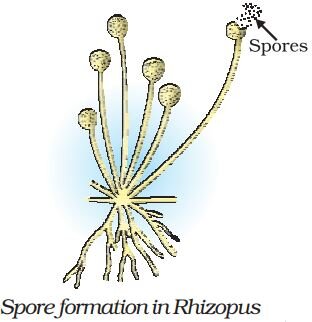
Sexual Reproduction
It involves two parents - male and female. A male gamete fuses with a female gamete to form a new cell called zygote. This zygote then grows and develops into a new organism.
Sexual reproduction in flowering plants:
Flowers are the reproductive organs of plants. It mainly consists of four parts - sepals, petals, stamen and pistil.
Stamen is the male reproductive part and produces pollen grains that contain male gametes. Each stamen has two parts - Filament and anther.
Carpel is the female reproductive part and produces ovules that contain female gametes. It has three parts - Stigma, style and ovary.
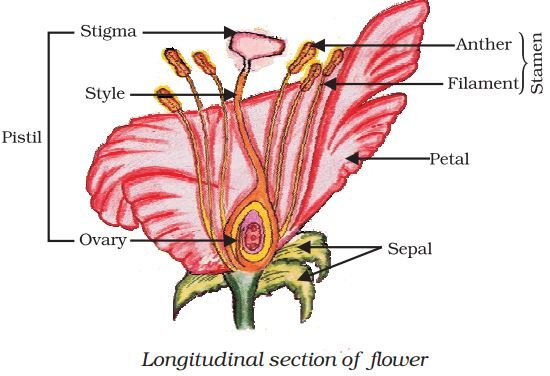
There are two type of flowers:
Unisexual: A flower that contains either male or female reproductive parts. For example - Papaya and watermelon.
Bisexual: A flower that contains both male and female reproductive parts. For example - Hibiscus and mustard.
Pollination: Transfer of pollen grains from the anther to the stigma of the flower is known as pollination.
It is of two types:
(i) Self-pollination: The transfer of pollen grains from the anther to the stigma of the same flower or another flower of the same plant.
(ii) Cross-pollination: The transfer of pollen grains from the anther to the stigma of another flower or another flower of a different plant of the same species. It is carried out with the help of external agents like insects, birds, wind and water.
Fertilization: Fertilization is the process of fusion of male and female gamete to form a zygote during sexual reproduction.
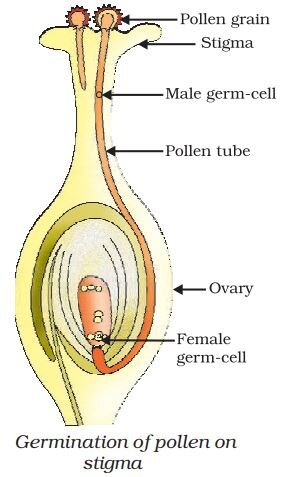
→ Pollen grains produced in the anther are transferred to the stigma of same flower or stigma of another flower.
→ A male gamete present in the pollen grains moves down the pollen tube.
→ The pollen tube enters the ovule in the ovary where the male gamete combines with the female gamete present in ovule to form a fertilized egg called zygote.
→ Zygote divides several times to form an embryo within the ovule. The ovule develops a tough coat and changes into seed gradually.
→ Ovary grows rapidly and changes into a fruit. The other parts of flower fall off.
The remaining part of the chapter will be presented here shortly.
Reproduction in Human Beings
- Humans reproduce bysexual mode of reproduction.
- Itincludes creation of the germ cells e., egg (ova) in the female and sperm in the male.
- Theperiod of sexual maturation is called Puberty.
Male Reproductive System
Male germ cells (sperms) are formed in the testes (male reproductive organ)
Male humans have two testes. They are located inside scrotum which is present outside the abdominal
Scrotum has a relatively low temperature needed for the production of sperms by testes.
Testes release a male sex hormone called testosterone. It helps to
- regulate the production of sperm
- bring about changes in appearance seen in boys at the time of puberty.
The sperms along with the secretion of prostate gland and seminalvesicle, form semen, which is released and made to enter into the female genital tract through Penis.
Female Reproductive System
The female germ cells or eggs (ova) are produced in the ovaries. (located in both side of abdomen).
At the time of birth of a girl child, the ovaries already contain thousands of immature eggs. Some of these eggs start maturing at the time of puberty. One egg (ovum) is produced every month by one of the ovaries.
The release of an ovum from the ovary into the abdominal cavity is known as ovulation.
The Egg is carried from the ovary to the womb through a fallopian tube. There are two fallopian tubes which unite to form an elastic bag like structure known as uterus. The Uterus opens into the vagina through the cervix.
Fertilization occurs in the fallopian tube of female genital tract.
The fertilized egg also called zygote gets implanted in the lining of the uterus, and start dividing. The inner lining of the uterus is richly supplied with blood vessels that help to nourish the growing embryo. The narrow end of the uterus is called cervix.
If zygote is not formed, the inner wall of uterus breaks which causes bleeding through vagina. This process is called Menstruation. It occurs at a regular interval of 28 days.
Also Read:
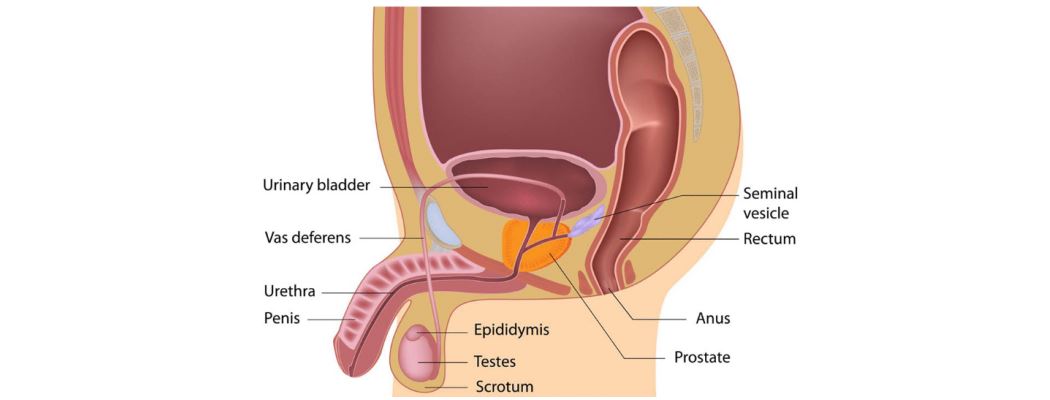
Comments
All Comments (0)
Join the conversation